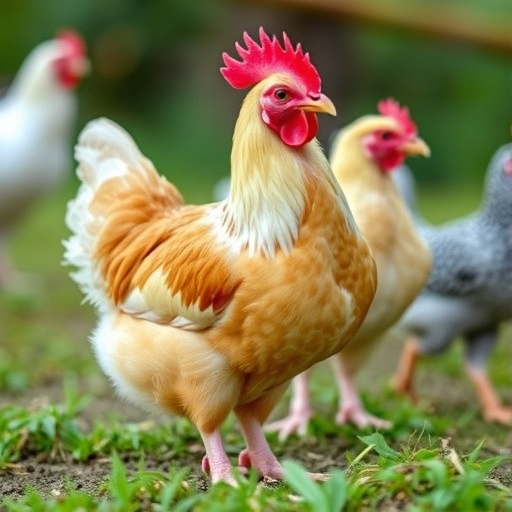
A groundbreaking study out of Texas A&M University reveals troubling projections for the future of broiler chicken fertility rates in the United States, indicating that by the year 2050, fertility could dip to nearly 60 percent. This significant decline threatens not only the poultry industry but also the broader food supply chain, with the potential to raise costs for consumers due to increasingly strained production efficiency. The research, published in the prestigious journal Poultry Science, dives deep into data collected over a decade and offers a sobering forecast that demands urgent attention from scientists and industry stakeholders alike.
The comprehensive analysis, spearheaded by graduate student Cara Cash with contributions from Kolton Witherspoon, and guided by avian geneticist Dr. Giri Athrey, examines data provided by the U.S. Department of Agriculture’s National Agricultural Statistics Service. The dataset spans from 2013 through 2022, capturing key performance indicators such as hatchability, chick viability, and overall production efficiency. These indicators collectively reveal a consistent downward trend in fertility rates, signaling a systemic issue within broiler breeder populations that could severely impact meat production volumes moving forward.
Hatchability, defined as the percentage of fertile eggs that successfully hatch into healthy chicks during incubation, is a critical measure in poultry production. Currently, the industry operates on an approximate 75 percent hatchability rate to sustain a supply of nine billion broiler chickens from some 12 billion eggs annually. However, researchers warn that if the observed decline continues at its current pace, hatchability rates may plummet to around 60 percent by mid-century. Such a reduction could cascade through the supply chain, causing bottlenecks and escalating costs associated with broiler chicken meat production.
This growing concern emerges amid rising consumer demand. Over the decade covered by the study, U.S. chicken production soared from 18.85 million tons in 2013 to 23.15 million tons in 2022, while the average per capita consumption jumped from just over 82 pounds to nearly 101 pounds. Maintaining this upward production trend depends heavily on stable and efficient broiler breeding programs. Yet, the decline in fertility rates adds an unexpected variable, forcing producers to adapt strategies that could increase operational costs throughout the entire industry.
To statistically assess these trends with precision, the research team developed a novel Broiler Breeder Performance Index. This composite metric integrates hatchability data with other production indicators to model long-term fertility patterns. The index underpins the study’s projections and substantiates concerns that have circulated within the poultry industry but lacked rigorous scientific backing until now. By deploying advanced data analysis techniques, the researchers provided a clearer, quantifiable understanding of the fertility decline phenomenon.
The study dives further into potential drivers behind these fertility drops. Among the factors considered are changes in management practices and the genetic selection strategies employed over the years. Modern broiler breeds have been genetically optimized for rapid growth and increased meat yield, possibly at the expense of reproductive performance. Such selections could inadvertently reduce fertility rates, creating a trade-off between production traits and reproductive capacity that the industry is now forced to reckon with.
Moreover, management variables such as diet, environmental conditions, and breeding protocols might exacerbate or alleviate fertility challenges. Despite intensive optimization, existing practices may no longer sufficiently address the complex reproductive biology of broiler breeders. The interaction between genetics and management thus emerges as a critical area for future research aimed at identifying sustainable solutions to halt or reverse the decline in fertility.
This issue holds not only scientific but also economic ramifications. Fertility declines directly affect hatchability, meaning more eggs are required to produce the same number of chickens. Producers have begun increasing the number of eggs set in incubation to compensate for lower hatch rates, but this approach raises costs and may strain resources, including energy inputs and labor. These added expenses are likely to reverberate downstream, potentially increasing prices for poultry products at retail.
Dr. Athrey emphasizes the urgency of addressing these findings: “Our investigation confirms long-held industry concerns with solid data. Without intervention, the fertility gap will expand, leading to higher expenditures to meet consumer demand and possibly impacting grocery store prices.” The study serves as a clarion call for coordinated action among geneticists, nutritionists, producers, and policymakers to develop innovative strategies that safeguard broiler fertility and maintain production efficiency.
In summary, this robust data-driven study delivers a critical warning that the trajectory of broiler breeder fertility is alarmingly downward. By providing a clear scientific foundation for this trend, it establishes an essential baseline for further research focused on counteracting this decline. The incorporation of the Broiler Breeder Performance Index represents a methodological advance that could monitor fertility trends continuously, enabling proactive adjustments and innovations to poultry breeding practices.
Looking ahead, the research team advocates a multidisciplinary approach to resolve this pressing issue. Future studies are needed to explore genetic lines that balance meat production with reproductive viability and to refine management techniques that support hen fertility and chick health. Such efforts will be vital to sustain the remarkable growth in U.S. chicken consumption and to ensure food security in an expanding global market.
Ultimately, as consumers increasingly rely on poultry for affordable and accessible protein, preserving the reproductive capacity of broiler breeders is paramount. This study shines a stark spotlight on the vulnerability within current production systems and underscores the critical need for science-driven interventions. The poultry industry’s ability to innovate and adapt will determine its resilience in the decades ahead, making this research a pivotal contribution to the future of sustainable animal agriculture.
Subject of Research: Animals
Article Title: How concerned should we be about broiler breeder fertility declines?
News Publication Date: March 7, 2025
Web References: https://www.sciencedirect.com/science/article/pii/S0032579125002317
References: DOI 10.1016/j.psj.2025.104992
Keywords: Poultry, Industrial production
Tags: avian genetic studiesbroiler chicken fertility declinechick viability trendsfood supply chain impactfuture of meat productionhatchability rates in chickenspoultry industry projectionspoultry science journal findingsproduction efficiency challengessystemic issues in poultry productionTexas A&M University researchU.S. Department of Agriculture data


